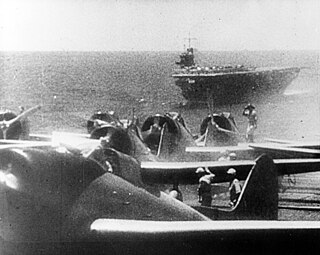
The Aichi D3A Type 99 Carrier Bomber is a World War II carrier-borne dive bomber. It was the primary dive bomber of the Imperial Japanese Navy (IJN) and was involved in almost all IJN actions, including the attack on Pearl Harbor.

The Junkers Ju 388Störtebeker is a World War II German Luftwaffe multi-role aircraft based on the Ju 88 airframe by way of the Ju 188. It differed from its predecessors in being intended for high altitude operation, with design features such as a pressurized cockpit for its crew. The Ju 388 was introduced very late in the war, and production problems along with the deteriorating war conditions meant that few were built.

The Focke-Wulf Fw 187 Falke ("Falcon") was a German aircraft developed in the late 1930s. It was conceived by Kurt Tank as a twin-engine, high-performance fighter, but the Luftwaffe saw no role for the design, perceiving it as intermediate between the Messerschmitt Bf 109 and Bf 110. Later prototypes were adapted to two-seats to compete with the Bf 110 in the heavy fighter (Zerstörer) role, but only nine aircraft were built in total.

The Junkers Ju 287 was a multi-engine tactical jet bomber built in Nazi Germany in 1944. It featured a novel forward-swept wing, and the first two prototypes were among the very few jet propelled aircraft ever built with fixed landing gear.

The Henschel Hs 132 was a World War II dive bomber and interceptor aircraft of the German Luftwaffe that never saw service. The unorthodox design featured a top-mounted BMW 003 jet engine and the pilot in a prone position. The Soviet Army occupied the factory just as the Hs 132 V1 was nearing flight testing, the V2 and V3 being 80% and 75% completed.

The Junkers Ju 89 was a heavy bomber designed for the Luftwaffe prior to World War II. Two prototypes were constructed, but the project was abandoned without the aircraft entering production. Elements of its design were incorporated into later Junkers aircraft.

The Yokosuka D4Y Suisei is a two-seat carrier-based dive bomber developed by the Yokosuka Naval Air Technical Arsenal and operated by the Imperial Japanese Navy from 1942 to 1945 during World War II. Development of the aircraft began in 1938. The first D4Y1 was complete in November 1940 and made its maiden flight at Yokosuka the following month.

The Hamburger Flugzeugbau Ha 137 was a German ground-attack aircraft of the 1930s. It was Blohm & Voss' entry into the contest to equip the re-forming Luftwaffe with its first purpose-built dive bomber. Although the contest would eventually be won by the Junkers Ju 87, the Ha 137 demonstrated that B&V's Hamburger Flugzeugbau, not even two years old at this point, had a truly capable design team of its own. One Ha 137 single-seat prototype competed against the Henschel Hs 123 at Rechlin.
The Junkers Ju 187 was a German projected dive bomber designed to replace the ageing Junkers Ju 87 Stuka. The Ju 187 was cancelled in 1943.

The Henschel Hs 130 was a German high-altitude reconnaissance and bomber aircraft developed in World War II. It suffered from various mechanical faults and was never used operationally, only existing as prototype airframes.

The Henschel Hs 124 was a twin-engine heavy fighter, attack aircraft and light bomber designed in Nazi Germany. After two prototypes had been built, work on the project was cancelled.

The Heinkel He 50 was a German World War II-era dive bomber, originally designed for the Imperial Japanese Navy. Serving in Luftwaffe prewar dive-bombing units, the He 50 served until almost the end of World War II as a night harassment bomber.

The Heinkel He 72 Kadett ("Cadet") was a German single-engine biplane trainer of the 1930s.

The Focke-Wulf Fw 56 Stösser was a single-engine, parasol monoplane advanced trainer, built in the 1930s in Germany.

The Heinkel HD 42 50, later designated the Heinkel He 42 was a German two-seat biplane seaplane originally designed for the Deutsche Verkehrsfliegerschule, and later built for the German Luftwaffe. The aircraft was used until the end of World War II as a trainer for maritime pilots.

The Blohm & Voss P 194 was a German design for a mixed-power Stuka or ground-attack aircraft and tactical bomber, during World War II.

The Arado Ar 81 was a German prototype dive bomber. Because the Reich Air Ministry decided to purchase the competing Junkers Ju 87, only three prototypes of the Ar 81 were completed.
The Focke-Wulf Nr. 238 Fernkampfflugzeug was a four-engine strategic bomber developed by the German aeronautical company Focke-Wulf-Flugzeugbau AG in the early 1940s and remained at the project stage. Designed to the same specifications issued by the Reichsluftfahrtministerium (RLM) which led to the Focke-Wulf Ta 400 and Junkers Ju 390, its development was cancelled by the RLM.
The Dornier Do 417 was a twin-engine multirole combat aircraft. Developed in 1942, it resulted from the Luftwaffe's request for a medium bomber, a contest in which Dornier, Junkers, Heinkel, and Blohm & Voss competed. In the end, the Junkers Ju 188 was chosen by the Luftwaffe, and the Do 417 never entered production.
















